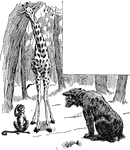
20 Star United States Flag, 1818
Black line illustration of a 20 Star United States flag. The additional stars represent the states of…

21 Star United States Flag, 1819
Black line illustration of a 21 Star United States flag. The additional star represents the state of…

23 Star United States Flag, 1820
Black line illustration of a 23 Star United States flag. The additional stars represent the states of…

24 Star United States Flag, 1822
Black line illustration of a 24 Star United States flag. The additional star represents the state of…

25 Star United States Flag, 1836
Black line illustration of a 25 Star United States flag. The additional star represents the state of…

26 Star United States Flag, 1837
Black line illustration of a 26 Star United States flag. The additional star represents the state of…

28 Star United States Flag, 1846
Black line illustration of a 28 Star United States flag. The additional star represents the state of…

29 Star United States Flag, 1847
Black line illustration of a 29 Star United States flag. The additional star represents the state of…

30 Star United States Flag, 1848
Black line illustration of a 30 Star United States flag. The additional star represents the state of…

31 Star United States Flag, 1851
Black line illustration of a 31 Star United States flag. The additional star represents the state of…

32 Star United States Flag, 1858
Black line illustration of a 32 Star United States flag. The additional star represents the state of…

33 Star United States Flag, 1859
Black line illustration of a 33 Star United States flag. The additional star represents the state of…

34 Star United States Flag, 1861
Black line illustration of a 34 Star United States flag. The additional star represents the state of…

35 Star United States Flag, 1863
Black line illustration of a 35 Star United States flag. The additional star represents the state of…

36 Star United States Flag, 1865
Black line illustration of a 36 Star United States flag. The additional star represents the state of…

37 Star United States Flag, 1867
Black line illustration of a 37 Star United States flag. The additional star represents the state of…

38 Star United States Flag, 1877
Black line illustration of a 38 Star United States flag. The additional star represents the state of…

43 Star United States Flag, 1890
Black line illustration of a 43 Star United States flag. The additional stars represent the states of…

44 Star United States Flag, 1891
Black line illustration of a 44 Star United States flag. The additional star represents the state of…

45 Star United States Flag, 1896
Black line illustration of a 45 Star United States flag. The additional star represents the state of…

46 Star United States Flag, 1908
Black line illustration of a 46 Star United States flag. The additional star represents the state of…

48 Star United States Flag, 1912
Black line illustration of a 48 Star United States flag. The additional stars represent the states of…

49 Star United States Flag, 1959
Black line illustration of a 49 Star United States flag. The additional star represents the state of…

50 Star United States Flag, 1960
Black line illustration of a 50 Star United States flag. The additional star represents the state of…

Black-capped Chickadee
"Crown and nape, with chin and throat, black, separated by white sides of the head. Upper parts brownish-ash,…
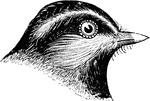
Mountain Chickadee
"Upper part ashy-gray, with scarcely a shade, and only on the rump, under parts similarly grayish-white,…
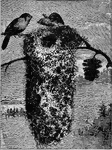
Two Least Bush-Tit Sitting on their Nest
"Dull lead-color, frequently with a brownish or olivaceous shade, the top of the head abruptly darker…
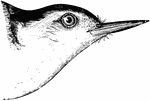
White-Breasted Nuthatch
"Upper parts, central tail-feathers, and much edging of the wings, clear ashy-blue; whole crown, nape,…

Red-breasted Nuthatch
"Upper parts leaden-blue the central tail-feathers the same; wings fuscous, with slight ashy edgings…

Brown-headed Nuthatch
"No black cap or white stripe on head. Upper parts dull ashy-blue; under parts sordid or muddy whitish.…

Crab's-Eye Vine
"Crab's-eye vine. Weather Plant. Fig. 64. - Height 10-12 ft.; frequently trailing over the ground S.:…

Rock Wren
"Upper parts pale brownish-gray, minutely dotted with blackish and whitish points together, and usually…
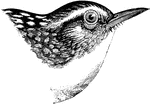
Long-billed Marsh Wren
"Long-billed Marsh Wren. T. palustris. Above clear brown, unbarred, the middle of the back with a large…

Shore Lark
"Shore Lark or Horned Lark. Upper parts in general pinkish-brown, this pinkish or vinaceous or liliaceous…
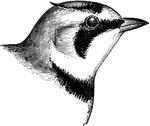
Shore Lark
"Shore Lark or Horned Lark. Upper parts in general pinkish-brown, this pinkish or vinaceous or liliaceous…
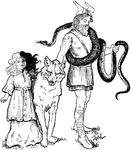
Loki and his Pets
Loki goes into Asgard with his daughter, Hela, and his pets, Jormundgand the serpent, and Fenris the…

Backgammon Board
"Backgammon, a game played by two persons upon a table or board made for the purpose, with pieces or…
Elephant & Bear Holding Banner
A pictorial banner illustrated with a bear and elephant holding up a cloth banner.
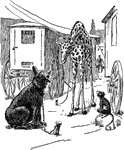
Giraffe Looking at Bear Cub Near Carts
An illustration of a giraffe looking at a young bear cub attached to a chain.
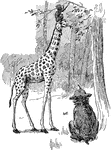
Giraffe Eating Leaves with a Monkey Sitting on Leaves
An illustration of a giraffe eating leaves with a monkey sitting on the giraffe's head.
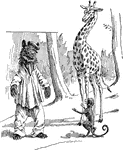
Bear Dressed in Shirt & Pants with Giraffe & Monkey
An illustration of a bear dressed in shirt and pants with a giraffe and monkey watching.
Grenadier
Grenadiers or rattails (less commonly whiptails) are generally large, brown to black gadiform marine…
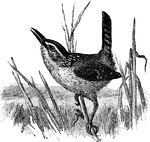
Marsh Wren
The Marsh Wren (Cistothorus palustris) is a small North American songbird of the wren family. It is…
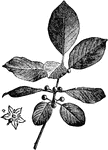
Alder Buckthorn
"Alder Buckthorn. Buckthorn, the name of an extensive genus of trees and shrubs, order Rhamnaceae."…
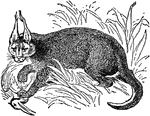
Caracal with Prey
"Caracal, a species of lynx; a native of Northern Africa and Southwestern Asia. It is about the size…

A White and Yellow Wagtail Sitting on the Rocks
A (Motacilla alba) or White Wagtail (upper) and a (Motacilla flava) Yellow Wagtail (lower) sitting on…
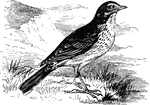
Meadow Pipit
"Meadow Pipit or Anthus pratensis. Upper parts greenish-brown distinctly marked with blackish-brown…

Black Throated Green Warbler
"Black Throated Green Warbler or Dendroica virens. Back and crown clear yellow-olive; forehead, superciliary…
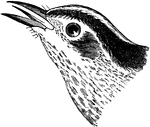
Black and White Creeper
"Black and White Creeper or Mniotilta varia. Black; edges of feathers of upper parts, coronal, superciliary,…

Worm-Eating Warbler
"Worm-Eating Warbler or Helmitheros vermivorus. Olive, below buffy, paler or whitish on the belly; head…
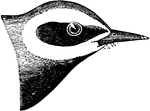
Blue Golden-Winged Warbler
"Blue Golden-Winged Warbler or Helminthophila chrysoptera. Upper parts slaty-blue, or or fine bluish-gray;…
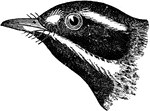
Black-throated Gray Warbler
"Black-throated Gray Warbler or Dendroica nigrescens. Above, bluish-ash, the interscapular region, and…
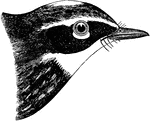
Yellow-rumped Warbler
"Yellow-rumped Warbler or Dendroica coronata. Yellow-crowned Warbler. Myrtle Bird. Slaty-blue, streaked…
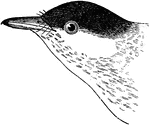
Black -poll Warbler
"Black-poll Warbler or Dendroica striata. Back, rump, tail-coverts grayish-olive, heavily streaked with…
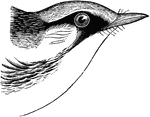
Chestnut-sided Warbler
"Chestnut-sided Warbler, Dendroica pensylvanica. Back streaked with black and pale yellow (sometimes…
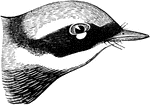
Magnolia Warbler
"Black -and-Yellow Warbler. Magnolia Warbler. Back black, usually quite pure and uninterrupted in the…

Ovenbird
"Golden-crowned Wagtail Warbler. Golden-crowned Accentor. Golden-crowned Thrush. Oven-bird. Seiurus…


